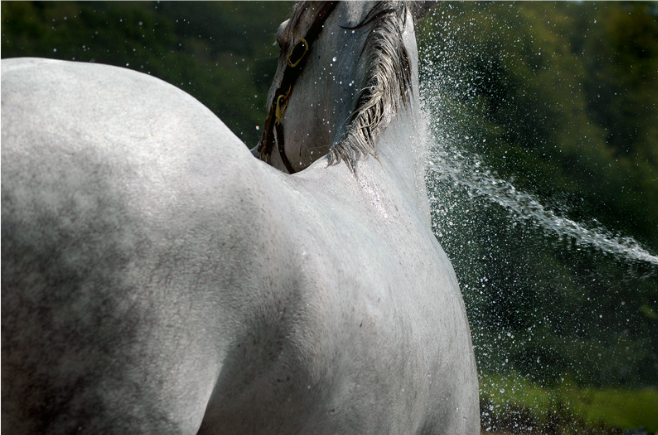
Start your summer right! Keep your horse cool during the hot summer months.
Keeping your horse cool during the hot summer months is essential for their health and comfort. Horses are sensitive to heat, and extreme temperatures can lead to dehydration, overheating, or heat stress. Here are some tips to help you keep your horse cool during the summer:
1. Provide Plenty of Fresh Water
• Always ensure access to clean, fresh water. Horses can drink up to 10-12 gallons per day, especially when it’s hot. Make sure water is available at all times, and consider using coolers or adding ice to the water to keep it refreshing.
• Electrolyte Supplements: During high heat, your horse may lose electrolytes through sweat. You can add an electrolyte supplement to their water to replace lost salts and minerals.
2. Shade and Shelter
• Provide access to shade to protect your horse from direct sunlight. This could be a stable, a run-in shed, or natural shade from trees. Horses should be able to retreat from the sun during the hottest parts of the day (usually from 11 AM to 3 PM).
• If you don’t have access to a shed or natural shade, consider installing shade cloths or tarps in the pasture or stable area.
3. Avoid Riding During the Hottest Parts of the Day
• Exercise early in the morning or late in the evening, when the temperatures are cooler. Avoid riding or exercising your horse during the peak heat of midday.
• Ride in shaded areas or use cool surfaces like sand or dirt tracks rather than asphalt or concrete, which can retain heat.
4. Cool Your Horse After Exercise
• After riding or exercising, cool your horse down properly by walking them for 10-15 minutes. This helps lower their heart rate and allows their body temperature to gradually decrease.
• Wash your horse with cool water (not ice-cold) and use a hose to spray water on their body, especially around their neck, legs, and underbelly. This will help to cool their skin and muscles.
• Scrape off excess water using a sweat scraper to help with evaporation. Repeat the process as needed to lower their body temperature.
5. Use Coolers or Blankets
• If your horse is sweating heavily, use a sweat cooler or a cooling blanket. These are designed to wick moisture away from the horse’s body, helping to regulate their temperature more effectively.
• Chilled gel wraps can also be used on the legs to cool down muscles after exercise.
6. Fly Protection
• During summer, flies and insects can cause stress and discomfort for your horse. Use fly masks, fly sheets, and fly spray to protect them from annoying insects, as this will help them focus on staying cool rather than swatting at flies.
• Horse fly rugs are breathable, UV-resistant, and can help protect your horse from both heat and insects.
7. Maintain a Healthy Diet
• Ensure that your horse is on a well-balanced diet to maintain their overall health and energy levels, especially during the summer. This helps them stay hydrated and manage the stress of high temperatures.
• Limit the amount of grain given during the hottest times of the day, as this can raise body temperature. Instead, focus on hay and grass during the morning and evening.
8. Groom Regularly
• Keep your horse clean and well-groomed to allow their coat to breathe and to remove sweat, dirt, and debris. This helps with natural cooling through the skin.
• If your horse has a thick winter coat, consider clipping it during the warmer months to help them stay cool, especially if they sweat a lot.
9. Turnout and Pasture Management
• Turn your horse out during the cooler parts of the day (early morning or late evening). If you are keeping them in a pasture, make sure they have access to plenty of fresh water and shade.
• Avoid turning them out during peak heat or when the humidity is high, as this can increase the risk of heat stress.
10. Monitor for Signs of Overheating
• Watch for signs of heat stress or heat exhaustion in your horse, such as:
• Excessive sweating or dry, hot skin
• Rapid breathing or heavy panting
• Lethargy or lack of appetite
• Excessive thirst and/or dark-colored urine
• Elevated heart rate
• Immediate action: If you notice any of these signs, cool the horse down immediately by walking them to a shaded area, spraying them with cool water, and offering water with electrolytes. If symptoms worsen, contact a vet right away.
11. Stable Cooling
• Ensure proper ventilation in your horse’s stable. Stables can become very hot during summer, especially if the barn is poorly ventilated. You can use fans or create cross-ventilation by opening windows and doors to allow air to circulate.
• If possible, consider installing a misting system or cooling fans in the barn to reduce the overall temperature.
Keeping your horse cool during the summer requires a combination of hydration, shade, proper exercise timing, cooling routines, and fly protection. By taking these steps, you can help ensure your horse stays comfortable, safe, and healthy during the hot summer months. Always monitor your horse’s condition, especially in extreme heat, and be ready to take action if you suspect they’re becoming overheated
